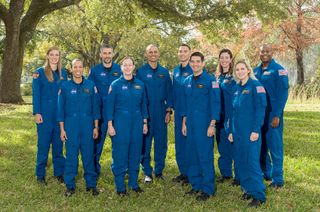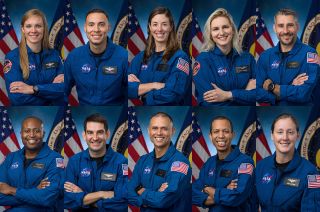NASA's new astronaut candidates report to Houston to begin training

HOUSTON — One month after being announced to the world, NASA's ten new astronaut candidates are reporting to work to begin two years of training.
The four women and six men, who were chosen from a pool of more than 12,000 applicants, are starting their new careers as future space station crew members and possible moonwalkers on Monday (Jan. 10). They are NASA's 23rd class of trainees and the 22nd to based at Johnson Space Center in Houston since 1962.
"NASA's Johnson Space Center is the home of our nation's human spaceflight program. This past November, we celebrated our 60th anniversary here in Houston, a tremendous milestone in the history of the U.S. space program," said Vanessa Wyche, director of Johnson Space Center, at the Dec. 6 ceremony that revealed the new astronaut candidates. "Our astronaut corps puts the 'human' in human spaceflight."
Related: How To Become An Astronaut
Those who pass the two years of instruction will join NASA's astronaut corps and become eligible for International Space Station (ISS) and Artemis moon mission assignments.
"We have multiple human spacecraft, so it has never been a more exciting time to embark on your career," said NASA Deputy Administrator Pam Melroy, a former space shuttle astronaut. "We are very focused on building a blueprint for how we will explore with humans, not just to the moon, not just onto Mars, but figuring out the blueprint for how we are going to go into the solar system."
"That is what we are focused on right now," Melroy said. "We are going to practice on the moon and we're going to push out, and that is going to be your generation."
Get the Space.com Newsletter
Breaking space news, the latest updates on rocket launches, skywatching events and more!
Related: What It's Like to Become a NASA Astronaut: 10 Facts
Opportunities ahead

NASA astronaut candidate (or "ascan") training falls into five major categories: operating and maintaining space station systems, spacewalking, robotics skills, piloting T-38 supersonic jets and Russian language skills.
Asked by collectSPACE.com what they were looking forward to most, the new ascans gave replies that were as varied as their backgrounds.
"One of the things that drew me to wanting to become an astronaut was the fact that you get to do all of these different things and learn how to do everything," said Christopher Williams, a medical physicist whose research focused on developing image guidance techniques for cancer treatments.
Marcos Berrios, a combat pilot in the U.S. Air National Guard with a doctorate in aeronautics and astronautics, replied similarly.
"I really like to learn about new topics and new concepts, so even learning Russian seems very exciting to me. Geology, learning how to fly the T-38 — it's hard for me to choose one," Berrios said. "Going into the pool and practicing spacewalking probably tops the list."
The "pool" is the neutral buoyancy laboratory (NBL), a 6.2 million gallon (23.5 million liter) tank that is large enough to submerge full-scale mockups of the space station's primary modules, as well as other spacecraft and payloads as is needed. Candidates learn the basics of working in the NBL while becoming familiar wearing an extravehicular mobility unit, or spacesuit.
Related: How astronauts prepare for the unknown in space
"I love working with my hands," said Christina Birch, a bioengineer and decorated track cyclist on the U.S. National Team. "I love wrenching on bikes, not just riding them, and so one of the things I am really looking forward to is being in the neutral buoyancy lab. developing spacewalking skills alongside my classmates."
Jessica Wittner, a naval aviator and test pilot in the U.S. Navy, was drawn to the new vehicles that she and her fellow candidates will learn to fly.
"We get to learn about all of the ISS systems and we're going to eventually get to work with the new SLS [Space Launch System] and Orion systems and everything that's coming online. So I think really just learning how everything works, how to maintain and operate it and successfully get us there and back — wherever there is — I think that's what I'm most excited about," she said.
Just being able to fly, especially using NASA's fleet of T-38 training jets, was the most popular reply among the ascans. The jets are used to expose astronauts to dynamic, unforgiving situations such as they might encounter in space.
"I'm excited to fly planes. I grew up with 'Top Gun,' the movie about the Navy pilots and I like things that go fast," said Andre Douglas, a naval architect and salvage engineer with the U.S. Coast Guard. "I used to dream about flying when I was a kid, so I think that will be a really cool skill set to have and just an experience to go through."
"I have a lot of love for aviation," said Deniz Burnham, an engineer and manager for energy industry drilling projects around the world. "I do have my helicopter license and my fixed-wing seaplane license, so I'm very curious about the T-38."
Jack Hathaway, a commander in the U.S. Navy with more than 2,500 flight hours in 30 types of aircraft, including more than 500 carrier-arrested landings, said he also looked forward to flying the T-38, but for a different reason than some of his classmates with less flight experience.
"One thing that I'm super excited about the training is taking people up flying in the T-38," he said. "I've done it only a couple times in my career, taking someone flying in a tactical jet or fast jet who has never done it before, but just being able to share that love of flight and get up into the sky — it's a different world up there."
Nichole Ayers, a major in the U.S. Air Force who led the first all-woman formation of the F-22 fighter jet in combat, was also looking forward to sharing experiences.
"I am actually most excited about just getting together with these amazing humans in my astronaut candidate class," Ayers said. "Being part of the team is the biggest thing for me."
Not all new to NASA
Some of the new candidates are not entirely new to NASA or the astronaut experience. Douglas, for example, recently worked on maritime robotics, planetary defense and space exploration missions for NASA at the Johns Hopkins University Applied Physics Lab.
"NASA is going to be needing robots in the future to help us [astronauts] with a lot of the exploration," he told collectSPACE. "There are going to be places where we can't go, there are going to be things that we need to do that we might not want to put ourselves out there first and we will need extensions of ourselves to be able to see things that we can't see."

Luke Delaney was flying as a research pilot at NASA's Langley Research Center in Virginia when he was selected to become an astronaut.
"I only had about a year and a half at Langley, but after transitioning from DOD [Department of Defense, U.S. Marine Corps] over to the government side, it was great exposure to how NASA does business. Seeing, on a small team level, how much effort goes in and how much data and science was getting accomplished was crazy," said Delaney. "Now to transition into the space, I am just really excited about that and ready for this team."
For Anil Menon, not only are the technical details of spaceflight not new, but neither is Johnson Space Center. He previously served as a NASA flight surgeon for a number of astronaut expeditions to the International Space Station and then became SpaceX's first flight surgeon, helping to launch the company's first humans into space during the Demo-2 mission of the Crew Dragon spacecraft.
"The wonderful thing about SpaceX is they expect you to be a technical expert, as well as your specialty, so I was also a flight controller, called a system operator, for the cargo Dragon. I had to learn a lot about Dragon to code procedures," Menon said. "What I am going to do here [as an astronaut candidate] is have to learn about Dragon, but also learn about all the other commercial partners' vehicles."
"I do think we are all on equal footing here because we will be just sharing our different insights across all these different vehicles as NASA works to move forward into Artemis, Mars missions and research support on the space station," he said.
Follow collectSPACE.com on Facebook and on Twitter at @collectSPACE. Copyright 2022 collectSPACE.com. All rights reserved.
Join our Space Forums to keep talking space on the latest missions, night sky and more! And if you have a news tip, correction or comment, let us know at: community@space.com.

Robert Pearlman is a space historian, journalist and the founder and editor of collectSPACE.com, an online publication and community devoted to space history with a particular focus on how and where space exploration intersects with pop culture. Pearlman is also a contributing writer for Space.com and co-author of "Space Stations: The Art, Science, and Reality of Working in Space” published by Smithsonian Books in 2018. He previously developed online content for the National Space Society and Apollo 11 moonwalker Buzz Aldrin, helped establish the space tourism company Space Adventures and currently serves on the History Committee of the American Astronautical Society, the advisory committee for The Mars Generation and leadership board of For All Moonkind. In 2009, he was inducted into the U.S. Space Camp Hall of Fame in Huntsville, Alabama. In 2021, he was honored by the American Astronautical Society with the Ordway Award for Sustained Excellence in Spaceflight History.

